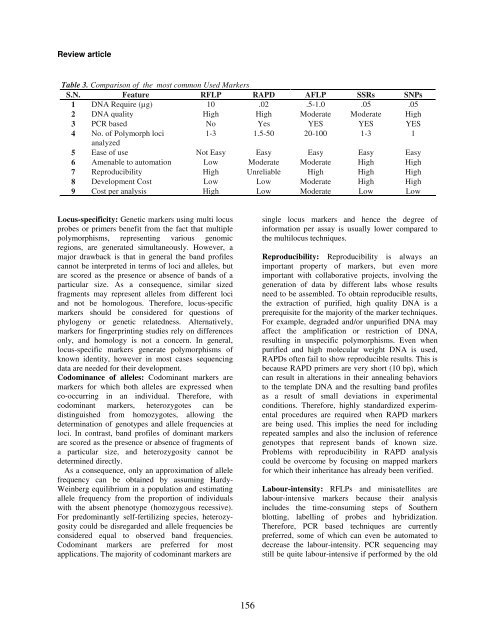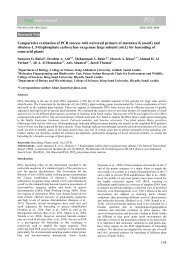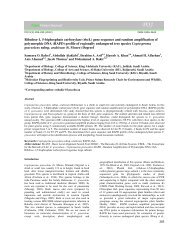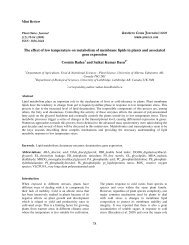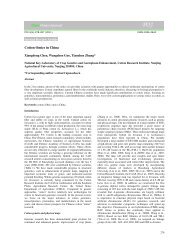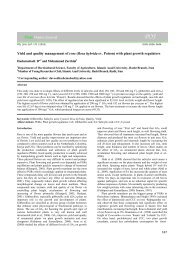Potential of Molecular Markers in Plant Biotechnology - ResearchGate
Potential of Molecular Markers in Plant Biotechnology - ResearchGate
Potential of Molecular Markers in Plant Biotechnology - ResearchGate
You also want an ePaper? Increase the reach of your titles
YUMPU automatically turns print PDFs into web optimized ePapers that Google loves.
Review article<br />
Table 3. Comparison <strong>of</strong> the most common Used <strong>Markers</strong><br />
S.N. Feature RFLP RAPD AFLP SSRs SNPs<br />
1 DNA Require (µg) 10 .02 .5-1.0 .05 .05<br />
2 DNA quality High High Moderate Moderate High<br />
3 PCR based No Yes YES YES YES<br />
4 No. <strong>of</strong> Polymorph loci<br />
1-3 1.5-50 20-100 1-3 1<br />
analyzed<br />
5 Ease <strong>of</strong> use Not Easy Easy Easy Easy Easy<br />
6 Amenable to automation Low Moderate Moderate High High<br />
7 Reproducibility High Unreliable High High High<br />
8 Development Cost Low Low Moderate High High<br />
9 Cost per analysis High Low Moderate Low Low<br />
Locus-specificity: Genetic markers us<strong>in</strong>g multi locus<br />
probes or primers benefit from the fact that multiple<br />
polymorphisms, represent<strong>in</strong>g various genomic<br />
regions, are generated simultaneously. However, a<br />
major drawback is that <strong>in</strong> general the band pr<strong>of</strong>iles<br />
cannot be <strong>in</strong>terpreted <strong>in</strong> terms <strong>of</strong> loci and alleles, but<br />
are scored as the presence or absence <strong>of</strong> bands <strong>of</strong> a<br />
particular size. As a consequence, similar sized<br />
fragments may represent alleles from different loci<br />
and not be homologous. Therefore, locus-specific<br />
markers should be considered for questions <strong>of</strong><br />
phylogeny or genetic relatedness. Alternatively,<br />
markers for f<strong>in</strong>gerpr<strong>in</strong>t<strong>in</strong>g studies rely on differences<br />
only, and homology is not a concern. In general,<br />
locus-specific markers generate polymorphisms <strong>of</strong><br />
known identity, however <strong>in</strong> most cases sequenc<strong>in</strong>g<br />
data are needed for their development.<br />
Codom<strong>in</strong>ance <strong>of</strong> alleles: Codom<strong>in</strong>ant markers are<br />
markers for which both alleles are expressed when<br />
co-occurr<strong>in</strong>g <strong>in</strong> an <strong>in</strong>dividual. Therefore, with<br />
codom<strong>in</strong>ant markers, heterozygotes can be<br />
dist<strong>in</strong>guished from homozygotes, allow<strong>in</strong>g the<br />
determ<strong>in</strong>ation <strong>of</strong> genotypes and allele frequencies at<br />
loci. In contrast, band pr<strong>of</strong>iles <strong>of</strong> dom<strong>in</strong>ant markers<br />
are scored as the presence or absence <strong>of</strong> fragments <strong>of</strong><br />
a particular size, and heterozygosity cannot be<br />
determ<strong>in</strong>ed directly.<br />
As a consequence, only an approximation <strong>of</strong> allele<br />
frequency can be obta<strong>in</strong>ed by assum<strong>in</strong>g Hardy-<br />
We<strong>in</strong>berg equilibrium <strong>in</strong> a population and estimat<strong>in</strong>g<br />
allele frequency from the proportion <strong>of</strong> <strong>in</strong>dividuals<br />
with the absent phenotype (homozygous recessive).<br />
For predom<strong>in</strong>antly self-fertiliz<strong>in</strong>g species, heterozygosity<br />
could be disregarded and allele frequencies be<br />
considered equal to observed band frequencies.<br />
Codom<strong>in</strong>ant markers are preferred for most<br />
applications. The majority <strong>of</strong> codom<strong>in</strong>ant markers are<br />
s<strong>in</strong>gle locus markers and hence the degree <strong>of</strong><br />
<strong>in</strong>formation per assay is usually lower compared to<br />
the multilocus techniques.<br />
Reproducibility: Reproducibility is always an<br />
important property <strong>of</strong> markers, but even more<br />
important with collaborative projects, <strong>in</strong>volv<strong>in</strong>g the<br />
generation <strong>of</strong> data by different labs whose results<br />
need to be assembled. To obta<strong>in</strong> reproducible results,<br />
the extraction <strong>of</strong> purified, high quality DNA is a<br />
prerequisite for the majority <strong>of</strong> the marker techniques.<br />
For example, degraded and/or unpurified DNA may<br />
affect the amplification or restriction <strong>of</strong> DNA,<br />
result<strong>in</strong>g <strong>in</strong> unspecific polymorphisms. Even when<br />
purified and high molecular weight DNA is used,<br />
RAPDs <strong>of</strong>ten fail to show reproducible results. This is<br />
because RAPD primers are very short (10 bp), which<br />
can result <strong>in</strong> alterations <strong>in</strong> their anneal<strong>in</strong>g behaviors<br />
to the template DNA and the result<strong>in</strong>g band pr<strong>of</strong>iles<br />
as a result <strong>of</strong> small deviations <strong>in</strong> experimental<br />
conditions. Therefore, highly standardized experimental<br />
procedures are required when RAPD markers<br />
are be<strong>in</strong>g used. This implies the need for <strong>in</strong>clud<strong>in</strong>g<br />
repeated samples and also the <strong>in</strong>clusion <strong>of</strong> reference<br />
genotypes that represent bands <strong>of</strong> known size.<br />
Problems with reproducibility <strong>in</strong> RAPD analysis<br />
could be overcome by focus<strong>in</strong>g on mapped markers<br />
for which their <strong>in</strong>heritance has already been verified.<br />
Labour-<strong>in</strong>tensity: RFLPs and m<strong>in</strong>isatellites are<br />
labour-<strong>in</strong>tensive markers because their analysis<br />
<strong>in</strong>cludes the time-consum<strong>in</strong>g steps <strong>of</strong> Southern<br />
blott<strong>in</strong>g, labell<strong>in</strong>g <strong>of</strong> probes and hybridization.<br />
Therefore, PCR based techniques are currently<br />
preferred, some <strong>of</strong> which can even be automated to<br />
decrease the labour-<strong>in</strong>tensity. PCR sequenc<strong>in</strong>g may<br />
still be quite labour-<strong>in</strong>tensive if performed by the old<br />
156


